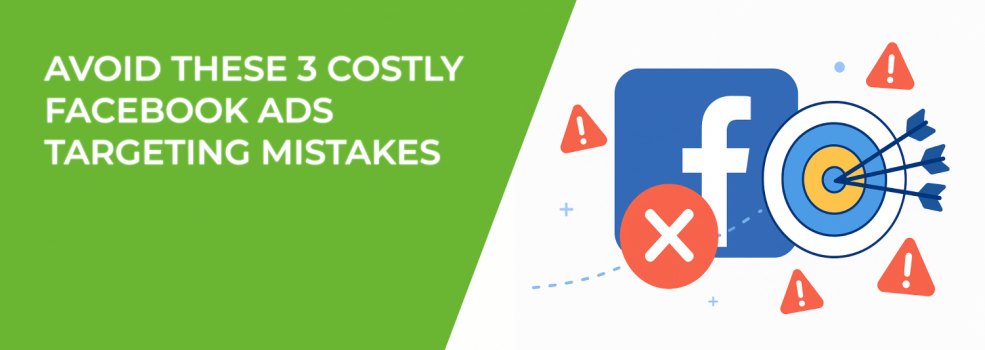When it comes to Facebook ads, targeting can make or break your results. You can have an amazing visual, a great hook, and a generous budget — but if you're showing your ads to the wrong people, your campaign won't get far.
Surprisingly, many advertisers are still falling into the same traps over and over again. And these mistakes aren’t just small slip-ups — they drain ad budgets, skew performance data, and reduce ROI.
Let’s break down three targeting mistakes that quietly kill campaigns and how to avoid them if you want smarter, more profitable Facebook ad results.
1. Relying Too Heavily on Broad Targeting Without Testing
Facebook’s algorithm is powerful. It’s tempting to think you can just target “Men, 25–45, United States” and let the platform find your buyers. Sometimes it works — especially with large budgets or when using broad top-of-funnel strategies — but advertisers often overestimate how effective this approach really is.
The problem? You lose control. And without structured testing, you won’t know why a campaign worked or failed.
Here’s what to do instead:
-
Start with layered targeting. Mix interests, behaviors, and demographics to create refined audience segments.
-
Test broad vs. narrow segments — not just once, but routinely. Watch how each performs in terms of CTR, CPM, and conversion rates.
-
Keep your ad creative aligned with the audience. Broad audiences need more universally appealing messaging. Niche audiences can handle more specific, detailed offers.
Even if Meta encourages broader audiences, don’t default to it without checking how it plays with your funnel and product. Are you looking for conversions or reach? That distinction matters more than the latest algorithm trend.
To dive deeper into audience targeting and get started with the basics, check out Facebook Ad Targeting 101: How to Reach the Right Audience.
2. Ignoring Audience Overlap
You launch a few ad sets — one targeting people who like Shopify, one for ecommerce store owners, and another for digital marketers. Sounds like a smart way to cover more ground, right?
Here’s the catch: many of those users are the same people. Facebook doesn’t automatically stop your ad sets from competing with each other in the auction, which means you could be bidding against yourself.
This creates inefficient spending and inflates your cost per result — all while making it harder to scale.
How to fix it:
-
Use Facebook’s audience overlap tool to identify when your ad sets are cannibalizing each other.
-
Group similar interests into one well-structured ad set, rather than splitting hairs across dozens of overlapping ones.
-
Test excluded audiences to make sure each campaign is reaching new users.
Think of your audience strategy like managing real estate. You don’t want to keep building houses on top of each other — it gets expensive and messy fast.
If you need more tips on refining your targeting, this article on The Role of Audience Overlap in Facebook Ads Performance is a great read.
3. Skipping Retargeting or Using It Poorly
Retargeting isn’t just a tactic for abandoned carts or checkout page visitors. It’s a powerful way to stay visible to people who’ve shown some level of interest — whether they watched a video, clicked an ad, or visited a landing page.
Yet many advertisers either ignore retargeting altogether or set it up without segmentation.
What often goes wrong:
-
One generic retargeting ad is shown to all users, regardless of their past behavior or stage in the funnel.
-
Retargeting windows are too long or too short — either annoying users or missing the conversion window.
-
Retargeting ads repeat the same message, even to users who’ve seen it multiple times.
Instead, try this:
-
Segment retargeting audiences based on how engaged they were — video viewers vs. website visitors vs. people who added to cart.
-
Use dynamic creatives and frequency caps to avoid fatigue.
-
Always adjust messaging based on the user’s prior actions. Ask yourself, “What would move this person one step closer to converting?”
Done right, retargeting feels less like stalking and more like smart follow-up. Are your campaigns doing that?
For a comprehensive guide on the value of retargeting, check out How to Define a Target Audience for Marketing: a Step-by-Step Guide.
Final Thought
Facebook ads can still be one of the most effective ways to grow a business — if you avoid burning money on poor targeting decisions.
So the next time you're building an audience, take a moment to check:
-
Are you trusting the algorithm too much?
-
Could your ad sets be stepping on each other’s toes?
-
Are you really using retargeting as strategically as you could?
Fixing these common mistakes won’t just improve performance — it’ll give you better data, more control, and higher returns.

